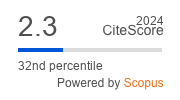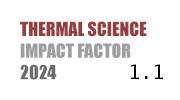THERMAL SCIENCE
International Scientific Journal
Thermal Science - Online First
online first only
Combustion and emission characterization of natural gas doped ammonia burner
ABSTRACT
Ammonia-doped natural gas combustion technology has attracted much attention because of its carbon reduction potential and fuel flexibility, but faces the dual challenges of unstable combustion due to uneven mixing in non-premixed combustion mode and the surge of NOx emission. In this study, a new cyclone doped combustor is designed through structural optimization, and the coupling mechanism of ammonia doping ratio on the flow, temperature and emission characteristics of the optimized combustor is systematically revealed. The optimized combustor synergized with the secondary air return improves the problem of slow flame speed of ammonia, and reduces the area of high-temperature zone and the peak concentration of thermal NO. The study on the effect of ammonia doping ratio shows that: with the increase of ammonia doping ratio from 0 to 0.8, the NO emission shows a non-monotonic tri-peak fluctuation, with the peak value of 757 ppmvd at Rm=0.4 and the minimum value of 445.67 ppmvd at Rm=0.6. The NO generation shows the evolution law of "promoting-suppressing-recovery", and this non-monotonicity comes from the dynamic equilibrium of fuel-type NOx and thermal-type NOx. This non-monotonicity results from the dynamic balance between fuel-based NOx and thermal NOx. The optimized combustor in this study effectively solves the problems of uneven mixing and high NOx emission level in single-stage non-premixed natural gas ammonia doped combustor, and provides a key theoretical basis for the multi-objective optimization of clean fuel doped combustor.
KEYWORDS
PAPER SUBMITTED: 2025-03-25
PAPER REVISED: 2025-05-19
PAPER ACCEPTED: 2025-05-24
PUBLISHED ONLINE: 2025-07-05
- Moradi R, Groth K M. Hydrogen storage and delivery: Review of the state of the art technologies and risk and reliability analysis[J]. International Journal of Hydrogen Energy, 2019, 44(23): 12254-12269
- Najjar Y S H. Hydrogen safety: The road toward green technology[J]. International Journal of Hydrogen Energy, 2013, 38(25): 10716-10728
- Colson S, Yamashita H, Oku K, et al. Study on the effect of injection temperature and nozzle geometry on the flashing transition of liquid ammonia spray[J]. Fuel, 2023, 348: 128612
- Chu H, Yao J, Dong W, et al. Comparative effects of H2 and NH3 on hydrocarbon fuels laminar combustion characteristics and pollutant emissions: Status and challenges[J]. International Journal of Hydrogen Energy, 2025, 109: 129-149
- Valera-Medina A, Marsh R, Runyon J, et al. Ammonia-methane combustion in tangential swirl burners for gas turbine power generation[J]. Applied Energy, 2017, 185: 1362-1371
- Hasan M H, Mahlia T M I, Mofijur M, et al. A comprehensive review on the recent development of ammonia as a renewable energy carrier[J]. Energies, 2021, 14(13): 3732
- Wang B, Li T, Gong F, et al. Ammonia as a green energy carrier: Electrochemical synthesis and direct ammonia fuel cell-a comprehensive review[J]. Fuel Processing Technology, 2022, 235: 107380
- Khade A R, Damodara V D, CHEN D H. Reduced Mechanism for Combustion of Ammonia and Natural Gas Mixtures[J]. Clean Technologies, 2023, 5(2): 484-496
- Shu B, He X, RAMOS C F, et al. Experimental and modeling study on the auto-ignition properties of ammonia/methane mixtures at elevated pressures[J]. Proceedings of the Combustion Institute, 2021, 38(1): 261-268
- Valera-Medina A, Marsh R, Runyon J, et al. Ammonia-methane combustion in tangential swirl burners for gas turbine power generation[J]. Applied Energy, 2017, 185: 1362-1371
- Hashemi S M, Wang P, Mao C, et al. Experimental study on the pollutant emissions of premixed ammonia/methane/air flame within porous burner[J]. Proceedings of the Institution of Mechanical Engineers, Part C: Journal of Mechanical Engineering Science, 2024, 238(9): 4139-4146
- Du Y, Zong S, Wang C, et al. Study on Mechanisms of NO x Formation and Inhibition during the Combustion of NH3/CH4 and NH3/CO Mixtures[J]. Applied Sciences, 2023, 13(21): 11847
- Yang Y, Zheng S, Sui R, et al. Impact of ammonia addition on soot and NO/N2O formation in methane/air co-flow diffusion flames[J]. Combustion and Flame, 2023, 247: 112483
- Zheng S, He Y, Hu B, et al. Effects of radiation reabsorption on the flame speed and NO emission of NH3/H2/air flames at various hydrogen ratios[J]. Fuel, 2022, 327: 125176
- Zheng S, He Y, Liu H, et al. Impacts of radiation reabsorption on the flame speed and NO generation of CH4/NH3/air flames[J]. Energy & Fuels, 2023, 37(7): 5632-5643
- Kurata O, Iki N, Matsunuma T, et al. Performances and emission characteristics of NH3-air and NH3-CH4-air combustion gas-turbine power generations [J]. Proceedings of the Combustion Institute, 2017, 36(3): 3351-3359
- Kurata O, Iki N, Inoue T, et al. Development of a wide range-operable, rich-lean low-NOx combustor for NH3 fuel gas-turbine power generation[J]. Proceedings of the combustion Institute, 2019, 37(4): 4587-4595
- Okafor E C, Somarathne K D K A, Ratthanan R, et al. Control of NOx and other emissions in micro gas turbine combustors fuelled with mixtures of methane and ammonia[J]. Combustion and flame, 2020, 211: 406-416
- Yang H M , Yeo J H , KIM N I .Optimized global reaction mechanism for H2+NH3+N2 mixtures[J]. International Journal of Hydrogen Energy, 2024, 73:749-760
- Bakali A E, Pillier L, Desgroux P, et al.NO prediction in natural gas flames using GDF-Kin®3.0 mechanism NCN and HCN contribution to prompt-NO formation[J]. Fuel, 2006,85(7):896-909
- Miller J A, Walch S P. Prompt NO: Theoretical prediction of the high - temperature rate coefficient for CH + N→HCN + N [J]. International Journal of Chemical Kinetics, 2015,29(4): 253-9
- Tu Y, Zhang H, Guiberti T F, et al. Experimental and numerical study of combustion and emission characteristics of NH3/CH4/air premixed swirling flames with air-staging in a model combustor[J]. Applied Energy, 2024, 367: 123370
- Xiao H, Lai S, Valera‐Medina A, et al. Experimental and modeling study on ignition delay of ammonia/methane fuels[J]. International Journal of Energy Research, 2020, 44(8): 6939-6949
- Dai L, Gersen S, Glarborg P, et al. Autoignition studies of NH3/CH4 mixtures at high pressure [J]. Combustion and Flame, 2020, 218: 19-26

